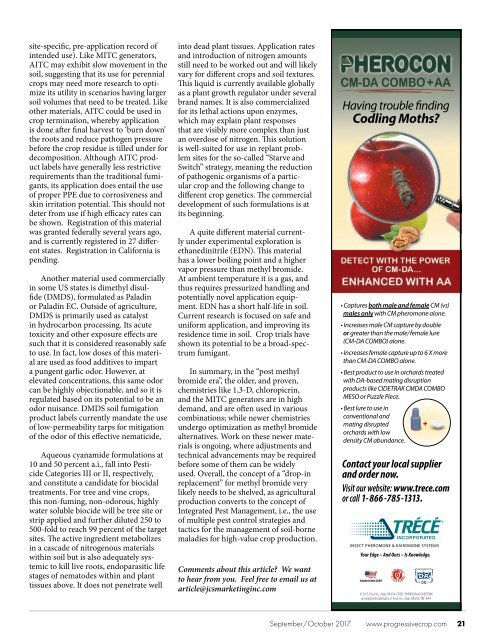September/October 2017
Create successful ePaper yourself
Turn your PDF publications into a flip-book with our unique Google optimized e-Paper software.
site-specific, pre-application record of<br />
intended use). Like MITC generators,<br />
AITC may exhibit slow movement in the<br />
soil, suggesting that its use for perennial<br />
crops may need more research to optimize<br />
its utility in scenarios having larger<br />
soil volumes that need to be treated. Like<br />
other materials, AITC could be used in<br />
crop termination, whereby application<br />
is done after final harvest to ‘burn down’<br />
the roots and reduce pathogen pressure<br />
before the crop residue is tilled under for<br />
decomposition. Although AITC product<br />
labels have generally less restrictive<br />
requirements than the traditional fumigants,<br />
its application does entail the use<br />
of proper PPE due to corrosiveness and<br />
skin irritation potential. This should not<br />
deter from use if high efficacy rates can<br />
be shown. Registration of this material<br />
was granted federally several years ago,<br />
and is currently registered in 27 different<br />
states. Registration in California is<br />
pending.<br />
Another material used commercially<br />
in some US states is dimethyl disulfide<br />
(DMDS), formulated as Paladin<br />
or Paladin EC. Outside of agriculture,<br />
DMDS is primarily used as catalyst<br />
in hydrocarbon processing. Its acute<br />
toxicity and other exposure effects are<br />
such that it is considered reasonably safe<br />
to use. In fact, low doses of this material<br />
are used as food additives to impart<br />
a pungent garlic odor. However, at<br />
elevated concentrations, this same odor<br />
can be highly objectionable, and so it is<br />
regulated based on its potential to be an<br />
odor nuisance. DMDS soil fumigation<br />
product labels currently mandate the use<br />
of low-permeability tarps for mitigation<br />
of the odor of this effective nematicide,<br />
Aqueous cyanamide formulations at<br />
10 and 50 percent a.i., fall into Pesticide<br />
Categories III or II, respectively,<br />
and constitute a candidate for biocidal<br />
treatments. For tree and vine crops,<br />
this non-fuming, non-odorous, highly<br />
water soluble biocide will be tree site or<br />
strip applied and further diluted 250 to<br />
500-fold to reach 99 percent of the target<br />
sites. The active ingredient metabolizes<br />
in a cascade of nitrogenous materials<br />
within soil but is also adequately systemic<br />
to kill live roots, endoparasitic life<br />
stages of nematodes within and plant<br />
tissues above. It does not penetrate well<br />
into dead plant tissues. Application rates<br />
and introduction of nitrogen amounts<br />
still need to be worked out and will likely<br />
vary for different crops and soil textures.<br />
This liquid is currently available globally<br />
as a plant growth regulator under several<br />
brand names. It is also commercialized<br />
for its lethal actions upon enzymes,<br />
which may explain plant responses<br />
that are visibly more complex than just<br />
an overdose of nitrogen. This solution<br />
is well-suited for use in replant problem<br />
sites for the so-called “Starve and<br />
Switch” strategy, meaning the reduction<br />
of pathogenic organisms of a particular<br />
crop and the following change to<br />
different crop genetics. The commercial<br />
development of such formulations is at<br />
its beginning.<br />
A quite different material currently<br />
under experimental exploration is<br />
ethanedinitrile (EDN). This material<br />
has a lower boiling point and a higher<br />
vapor pressure than methyl bromide.<br />
At ambient temperature it is a gas, and<br />
thus requires pressurized handling and<br />
potentially novel application equipment.<br />
EDN has a short half-life in soil.<br />
Current research is focused on safe and<br />
uniform application, and improving its<br />
residence time in soil. Crop trials have<br />
shown its potential to be a broad-spectrum<br />
fumigant.<br />
In summary, in the “post methyl<br />
bromide era”, the older, and proven,<br />
chemistries like 1,3-D, chloropicrin,<br />
and the MITC generators are in high<br />
demand, and are often used in various<br />
combinations; while newer chemistries<br />
undergo optimization as methyl bromide<br />
alternatives. Work on these newer materials<br />
is ongoing, where adjustments and<br />
technical advancements may be required<br />
before some of them can be widely<br />
used. Overall, the concept of a “drop-in<br />
replacement” for methyl bromide very<br />
likely needs to be shelved, as agricultural<br />
production converts to the concept of<br />
Integrated Pest Management, i.e., the use<br />
of multiple pest control strategies and<br />
tactics for the management of soil-borne<br />
maladies for high-value crop production.<br />
Comments about this article? We want<br />
to hear from you. Feel free to email us at<br />
article@jcsmarketinginc.com<br />
Having trouble finding<br />
Codling Moths?<br />
• Captures both male and female CM (vs)<br />
males only with CM pheromone alone.<br />
• Increases male CM capture by double<br />
or greater than the male/female lure<br />
(CM-DA COMBO) alone.<br />
• Increases female capture up to 6 X more<br />
than CM-DA COMBO alone.<br />
• Best product to use in orchards treated<br />
with DA-based mating disruption<br />
products like CIDETRAK CMDA COMBO<br />
MESO or Puzzle Piece.<br />
• Best lure to use in<br />
conventional and<br />
mating disrupted +<br />
orchards with low<br />
density CM abundance.<br />
Contact your local supplier<br />
and order now.<br />
Visit our website: www.trece.com<br />
or call 1- 866 -785-1313.<br />
INCORPORATED<br />
INSECT PHEROMONE & KAIROMONE SYSTEMS<br />
Your Edge – And Ours – Is Knowledge.<br />
© <strong>2017</strong>, Trécé Inc., Adair, OK USA • TRECE, PHEROCON and CIDETRAK<br />
are registered trademarks of Trece, Inc., Adair, OK USA, TRE-1044<br />
®<br />
<strong>September</strong>/<strong>October</strong> <strong>2017</strong><br />
www.progressivecrop.com<br />
21


















